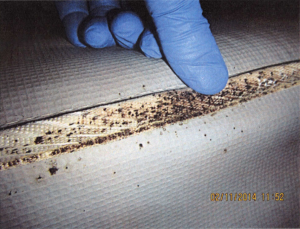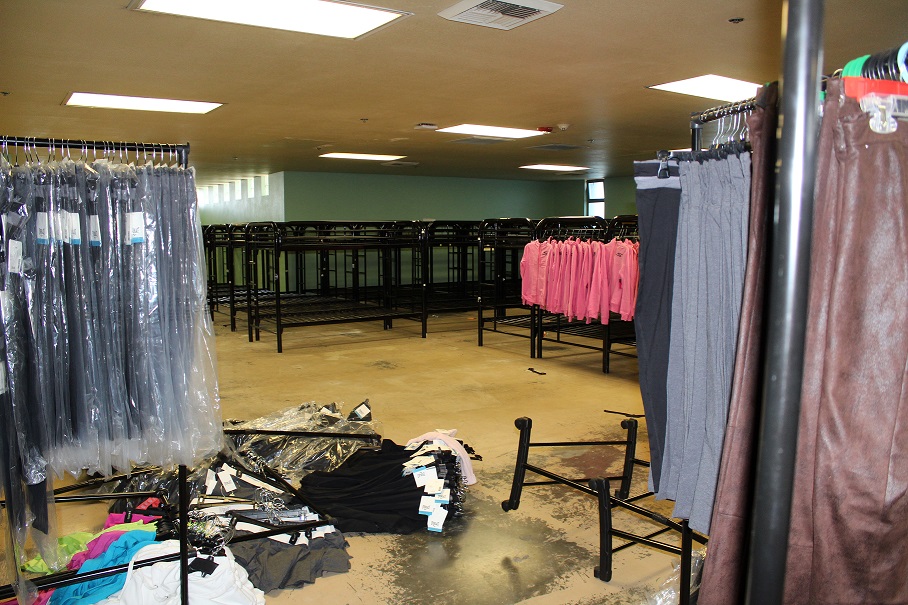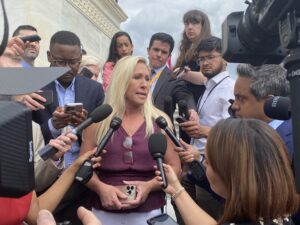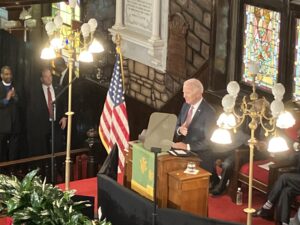3:45
News Story
Unhealthy and unregulated: Conditions in local shelters draw complaints
The Shade Tree Shelter in Las Vegas has a unique mission, describing itself as “the only 24-hour accessible shelter designed specifically to meet the needs of women and children in Southern Nevada.”
But women and children staying at the shelter have also been exposed to excessive black mold, suffering respiratory related illnesses as a result, allege a series of complaints filed over the last four years with the Southern Nevada Health District (SNHD).
“There is no mold,” said Stacey Lockhart, executive director of the Shade Tree. “Unfortunately, we do have women who stay here that aren’t necessarily the happiest because they’re not getting everything they want. You know, we are a shelter, we’re not a luxury hotel.”
If Shade Tree were a hotel, luxury or otherwise, it would be subject to regular inspections by the SNHD. But the shelter is exempt from the inspections that are routine for other public accomodations.
Lockhart says the facility was tested for mold earlier this year but none was found. She she could not provide testing records as of publication.
A resident’s complaint dated 2013 and filed with the Nevada Division of Public Health alleges that women and children developed cases of scabies after staying at Shade Tree. The complaint made its way to the SNHD, but not until 2015. State health officials contend the report was misdated, and actually filed in 2015.

But a delayed response to a health complaint for a homeless shelter may not be unexpected given the lack of oversight of shelters in Clark County. A number of complaints filed with the SNHD from people staying at local shelters describe barely habitable facilities rife with filth, bed bugs, mold, roaches, food contamination, soap scum, “unhealthy” temperatures, roof leaks, the smell of sewage and other noxious odors.
Health Department officials say they are powerless to do much about it; shelter health and safety standards are nearly nonexistent.
“We don’t have legal authority”
The SNHD, which regulates and monitors public health, has no jurisdiction over homeless shelters, which are in part, publicly funded. The most an inspector can do is offer a courtesy visit and make recommendations to improve shelter conditions.
At times the SNHD will even forego an inspection of the facility altogether, discussing complaints with management over the phone or by email and closing out complaints without visiting the facility.
“Even if it’s a public space we don’t have legal authority under Nevada revised statutes to go in there and do certain things,” said Jennifer Sizemore, the public information manager at the SNHD.
Kitchens in shelters are not required to obtain food permits, as non-profit and religious organizations are exempt from SNHD food establishment regulations, raising the question of who is in charge of correcting health issues in unregulated public kitchens.
One complaint filed against Shade Tree, which does not have a food permit for its kitchen, alleged the kitchen employed poor health standards and was infested with roaches.
“It’s not that we don’t care. We want everyone to be doing good things but we can’t overstep our legal authority. No agency can,” Sizemore said.
Las Vegas was the smallest city among the 10 largest homelessness populations in the U.S. in 2017. According to the U.S. Department of Housing and Urban Development’s annual report, there is no clear regulatory structure for emergency shelters.
Some states have made strides to standardize and oversee health and safety policies in shelters. In New York State, the Division of Shelter Oversight and Compliance certifies and conducts annual inspections of publicly funded homeless shelters to ensure shelters are safe, clean, supervised and well maintained. The Joint Office of Homeless Services in Oregon, which was created in 2001 to improve conditions at shelters, works in a similar fashion.
“People didn’t want to stay in the shelters because there were so many issues,” said Denis Pheriaulp, a spokesperson for The Joint Office of Homeless Services in Oregon.
The streets: Cleaner than shelters?
One woman, whose name was redacted from a complaint, wrote, “I was in the program at Catholic Charities after moving here from [Florida] after divorce. I have had to leave the program due to being bitten by bed bugs that twice have put me in the emergency room. I now live on the streets due to the disease and unsafe health conditions of the facility.”
Some shelters, like Shade Tree, have confidentiality clauses in their intake process that prevent people staying in a shelter from reporting issues to outside sources. Taking photos inside the shelter is prohibited and can end in being dismissed from the shelter.
“When women go out and do that it doesn’t help me help anyone else in this building,” Lockhart said of the need for the confidentiality clause. Lockhart also added that these rules are put in place to protect women because to the nature of the facility, which can house victims of domestic violence.
For some homeless people the risk of sleeping outside a shelter is preferable to staying in a shelter. Many homeless people fear they might contract diseases like tuberculosis (TB), which spreads easily in densely, populated close quarters. Some homeless people say they are unable to fall asleep in shelters due to the perpetual coughing.
According to the Centers for Disease Control and Prevention, a disproportionate number of TB cases occur among high-risk populations, including people experiencing homelessness.
Homeless shelters are filled to 96 percent capacity throughout the year, According to the Nevada Homeless Alliance.
Ross, 67, is one of the many homeless people who chose to stay away from the shelters downtown and instead spends his days at Huntington Circle Park, a veterans memorial park on South Maryland Parkway. In 2006 the park was shut down by the city because of ongoing safety issues with the homeless, including the fatal stabbing of a homeless man. It reopened in 2011.
“People are breathing on each other, lots of diseases. They even keep the place cold, like a hospital, like a prison,” Ross, who declined to give a last name, said of the shelters. He says there are more bed bugs in the shelter than outside.
He wears a crisp white and blue checkered shirt, pressed blue jeans, and a Baltimore Ravens hat. Ross came to Las Vegas to retired, lured by the city’s slick image on screen. Ross receives social security and lived in an apartment till about three years ago before his apartment changed management, underwent a cosmetic renovation and passed on a rent hike he couldn’t afford.
“They painted it, colored it. It was the same place. They didn’t even fix it,” Ross said.
Ronald Mecklosky, an activist for homeless rights, is one of the leaders for Food Not Bombs, a non-profit aid project that provides meals to the homeless at Huntridge Circle Park throughout the week.
“One thing people have a misconception of is what being homeless is. Our neighbors, this fine neighborhood, some are right on the cusp. They have to decide, ‘do I pay my rent or my mortgage? Or do I buy groceries, do I buy my medication?’” Mecklosky said.
Some local publicly funded emergency shelters, like Salvation Army, even charge the homeless to stay. The Salvation Army’s free shelter is closed during the summer. Instead, the Salvation Army charges $15 per day to those seeking to escape the desert heat.
Not a powerful constituency
In 2017, about 6,500 people were homeless on a given night in Clark County with a little more than 30 percent staying in emergency shelters, transitional housing programs, or safe havens, and the rest living in unsheltered locations like encampments and parks.
According to surveys conducted by Help Hope Home, emergency shelters have been the second most used service by the homeless in Southern Nevada for the last four years, the first being free meals.
Nevada has traditionally been meager when committing resources to social services, and the high-powered movers and shakers who influence local governments don’t have homeless people as clients, rendering homeless programs largely dependent on federal funds and public donations for survival.
While emergency shelters are one of the most used services by the homeless, according to the organization Help Hope Home, they’re allocated relatively little public funding. The City of Las Vegas received over $9 million in funding from HUD in 2018, but passed on only about $300,000 to be divided among emergency shelters such as Shade Tree, Catholic Charities, the Salvation Army, and Family Promise.
HUD “does not like to fund transitional housing programs,” said Terry Lindemann, the executive director of Family Promise, a non-profit organization that offers emergency shelter to families. She believes emergency shelters and transitional housing is a vital part of getting people off the streets. “Families need somewhere to get help and get off the street while they are waiting to try and find affordable housing.”
Shade Tree under new leadership
In the last four years of complaint to the SNHD, Shade Tree received the most of all emergency shelters.
Since Lockhart took over leadership of the Shade Tree in July, no complaints against the facility have been filed with the SNDH.
Bathrooms at the Shade Tree are now under renovations, tiles, countertops and mirrors are all torn out.
Lockhart says a variety of trade unions including electricians, carpenters, and bricklayers have been working on the renovations. As well as waterproof workers and tilers for the showers. She has also been working to establish partnerships with the community partners to meet the needs of the shelter.
Murals of inspiration aspirations and vibrant paintings cover the walls, butcher paper still lining the floor from the work done the day before.
Their goal is to reopen the third floor by September exclusively for victims of domestic violence and victims of sex trafficking. But what about other women?
Lockhart said the Shade Tree’s financial and physical operations are in much better shape than even a few years ago, admitting that before she arrived there were major issues with the condition of the shelter.
“A year ago you wouldn’t have been given a tour,” Lockhart said.
In the 17 years the building has stood, nothing had been done to improve it, Lockhart said. Stories of harsh living conditions at the shelter have been reported before.
The facility is visibly baren. The common areas, where women are meant to stay during the hours the sleeping area is closed, lacks furnishing and purpose.
Former residents of the Shade Tree like Leziah Strong, who left the shelter with her wife, said they chose not to stay in the shelter because they did not have the resources they say they had and could not help them.
“We can only do what we have funding to do,” Lockhart said.
Our stories may be republished online or in print under Creative Commons license CC BY-NC-ND 4.0. We ask that you edit only for style or to shorten, provide proper attribution and link to our website. AP and Getty images may not be republished. Please see our republishing guidelines for use of any other photos and graphics.




